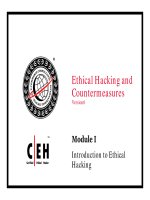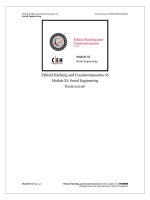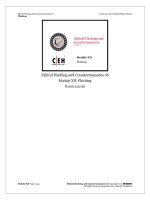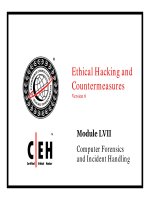Ethical hacking and countermeasures - phần 12 pptx
Bạn đang xem bản rút gọn của tài liệu. Xem và tải ngay bản đầy đủ của tài liệu tại đây (2.6 MB, 63 trang )
Ethical Hacking and
Countermeasures
Countermeasures
Version 6
dl
Mo
d
u
l
e XII
Phishing
News
EC-Council
Copyright © by EC-Council
All Rights Reserved. Reproduction is Strictly Prohibited
Source: />Module Objective
This module will familiarize you with:
Introduction
Reasons for Successful Phishing
Phishing Methods
Phishing Methods
Process of Phishing
Types of Phishing Attacks
EC-Council
Copyright © by EC-Council
All Rights Reserved. Reproduction is Strictly Prohibited
Anti-phishing Tools
Module Flow
Introduction Process of Phishing
Reasons for
Successful Phishing
Types of Phishing
Attacks
Successful Phishing
Attacks
Phishing Methods Anti-phishing Tools
EC-Council
Copyright © by EC-Council
All Rights Reserved. Reproduction is Strictly Prohibited
Phishing- Introduction
EC-Council
Copyright © by EC-Council
All Rights Reserved. Reproduction is Strictly Prohibited
News
EC-Council
Copyright © by EC-Council
All Rights Reserved. Reproduction is Strictly Prohibited
Source:
Introduction
Phishing is an Internet scam where the user is convinced to give
valuable information
valuable information
Phishing will redirect the user to a different website through
emails, instant messages, spywares etc.
Phishers offer ille
g
itimate we
b
sites to the user to fill
p
ersonal
gb p
information
The main purpose of phishing is to get access to the customer
’
s
The main purpose of phishing is to get access to the customer s
bank accounts, passwords and other security information
Phi hi k h di h h
ili
EC-Council
Copyright © by EC-Council
All Rights Reserved. Reproduction is Strictly Prohibited
Phi
s
hi
ng
attac
k
s
can
target
t
h
e
au
di
ence
t
h
roug
h
mass- ma
ili
ng
millions of email addresses around the world
Reasons for Successful Phishing
Lack of knowledge
• Lack of computer system knowledge by the user (as how the emails and
web works) can be exploited by the phishers to acquire sensitive
information
•Man
y
users lack the knowled
g
e of securit
y
and securit
y
indicators
ygyy
•
Phishers can fool users by convincing them to get into a fake website with
Visual deception
Phishers can fool users by convincing them to get into a fake website with
the domain name slightly different from the original website which is
difficult to notice
• They use the images of the legitimate hyperlink, which itself helps as a
hyperlink to an unauthorized website
hih k h b i h i i h f b
•P
hi
s
h
ers
trac
k
t
h
e
users
b
y
us
i
ng
t
h
e
i
mages
i
n
t
h
e
content
o
f
a
we
b
page
that looks like a browser window
• Keeping an unauthorized browser window on top of, or next to a
legitimate window having same looks, will make the user believe that they
are from the same source
EC-Council
Copyright © by EC-Council
All Rights Reserved. Reproduction is Strictly Prohibited
are from the same source
• Setting the tone of the language same as the original website
Reasons for Successful Phishing
(cont
’
d)
(cont d)
Not
g
ivin
g
attention to Securit
y
Indicators
• Users don’t give proper attention to read the warning
messages or security indicators
gg y
• In the absence of security indicators it will be easy to
insert spoofed images which will go unidentified by the
users
EC-Council
Copyright © by EC-Council
All Rights Reserved. Reproduction is Strictly Prohibited
Phishing Methods
Eil d S
• Most of the phishing attacks are done through email
E
ma
il
an
d S
pam
• Phishers can send millions of emails to valid email
addresses by using the techniques and tools opted by
spammers
•Phishin
g
emails
p
rovide a sense of ur
g
enc
y
in the
gp gy
minds of the user to give the important information
• Phishers take the advantage from SMTP flaws by
adding fake “Mail from” header and incorporate any
or
g
anization of choice
g
• Minor changes are made in the URL field by sending
mimic copies of legitimate emails
EC-Council
Copyright © by EC-Council
All Rights Reserved. Reproduction is Strictly Prohibited
Phishing Methods (cont’d)
Web-based Delivery
• This type of attack is carried out by targeting the
customers through a third party website
Providing malicious website content is a popular
•
Providing malicious website content is a popular
method of phishing attacks
• Keeping fake banner advertisements in some
reputed websites to redirect the customers to the
phishing website is also a form of web based delivery
phishing website is also a form of web based delivery
IRC and Instant Messa
g
in
g
• IRC and IM clients allow for embedded dynamic
content
gg
EC-Council
Copyright © by EC-Council
All Rights Reserved. Reproduction is Strictly Prohibited
• The attackers send the fake information and links to
the users through IRC and IM
Phishing Methods (cont’d)
Trojaned Hosts
• Trojan is a program that gives complete access of host computer
to
phishers
after being installed at the host computer
Trojaned Hosts
to
phishers
after being installed at the host computer
• Phishers will make the user to install the trojaned software which
helps in email propagating and hosting fraudulent websites
EC-Council
Copyright © by EC-Council
All Rights Reserved. Reproduction is Strictly Prohibited
Process of Phishing
The process involved in building a successful phishing site
is:
Registering a fake domain name
Building a look alike website
Sending emails to many users
EC-Council
Copyright © by EC-Council
All Rights Reserved. Reproduction is Strictly Prohibited
Types of Phishing Attacks
Types of Phishing Attacks
EC-Council
Copyright © by EC-Council
All Rights Reserved. Reproduction is Strictly Prohibited
News
EC-Council
Copyright © by EC-Council
All Rights Reserved. Reproduction is Strictly Prohibited
Source:
Man-in-the-Middle Attacks
In this attack, the attacker’s computer is placed between the customer’s computer and
the real website. This helps the attacker in tracking the communications between the
systems
This attack supports both HTTP and HTTPS communications
In order to make this attack successful, the attacker has to direct the customer to
proxy server rather than the real server
T t P i l t d t th l t ll th d t b
The following are the techniques used to direct the
customer to proxy server:
•
T
ransparen
t P
rox
i
es
l
oca
t
e
d
a
t th
e
rea
l
server
cap
t
ures
a
ll th
e
d
a
t
a
b
y
forcing the outbound HTTP and HTTPS traffic towards itself
• DNS Cache Poisoning can be used to disturb the normal traffic routing by
establishing false IP address at the key domain names
B fi ti i d t t fi ti ti b
EC-Council
Copyright © by EC-Council
All Rights Reserved. Reproduction is Strictly Prohibited
•
B
rowser
proxy
con
fi
gura
ti
on
i
s
use
d t
o
se
t
a
proxy
con
fi
gura
ti
on
op
ti
ons
b
y
overriding the users web browser settings
URL Obfuscation Attacks
The user is made to follow a URL by sending a message which navigates
th t th tt k ’
th
em
t
o
th
e
a
tt
ac
k
er
’
s
server
The different methods of URL obfuscation
• Making few changes to the authorized URL’s which
m
a
k
es d
iffi
cu
l
t to
i
de
n
t
if
y
i
t as a p
hi
s
hin
g s
i
te
include:
a es d cu t to de t y t as a p s g s te
• Giving friendly login URL’s to the users which negates
the complexity of authentication that navigates them to
the look-a-like target URL
•
Many third party organizations offer to design shorter
•
Many third party organizations offer to design shorter
URL’s for free of service, which can be used to obfuscate
the true URL
• The IP address of a domain name can be used as a part of
th URL t bf t th h t d l t b t t
EC-Council
Copyright © by EC-Council
All Rights Reserved. Reproduction is Strictly Prohibited
th
e
URL t
o
o
bf
usca
t
e
th
e
h
os
t
an
d
a
l
so
t
o
b
ypass
con
t
en
t
filtering systems
Cross-site Scripting Attacks
hfk
kf d
T
h
is type o
f
attac
k
ma
k
es use o
f
custom URL or co
d
e to inject into a
valid web-based application URL or imbedded data field
Most of the CSS attacks are carried out using URL formatting
EC-Council
Copyright © by EC-Council
All Rights Reserved. Reproduction is Strictly Prohibited
Hidden Attacks
Attacker uses the HTML DHTML or other
•
Change the display of rendered information by interpreting with
Attacker uses the HTML
,
DHTML
,
or other
scriptable code to:
Change the display of rendered information by interpreting with
the customers’ web browser
• Disguise content as coming from the real site with fake content
Hidd F
Methods used for hidden attacks are:
•
Hidd
en
F
rame:
• Frames are used to hide attack content with their uniform browser
support and easy coding style
• Overridin
g
Pa
g
e Content
EC-Council
Copyright © by EC-Council
All Rights Reserved. Reproduction is Strictly Prohibited
gg
• Graphical Substitution
Client-side Vulnerabilities
Most customers are vulnerable towards the
p
hishin
g
attacks while
pg
they browse the web for any software
These client side vulnerabilities can be exploited in a number of ways
These client side vulnerabilities can be exploited in a number of ways
similar to the worms and viruses
The anti virus software are not useful for these vulnerabilities as they
are harder to identify
EC-Council
Copyright © by EC-Council
All Rights Reserved. Reproduction is Strictly Prohibited
Deceptive Phishing
The common method of deceptive phishing is email
Phishser sends a bulk of deceptive emails which command the user to click on
the link
p
rovided
p
Phisher’s call to action contains daunting information about the recipient’s
account
Phisher then collects the confidential information given by the user
EC-Council
Copyright © by EC-Council
All Rights Reserved. Reproduction is Strictly Prohibited
Malware-Based Phishing
In this method,
phishers
use
malicious software to
attack on the user machines
In this method,
phishers
use
malicious software to
attack on the user machines
This
p
hishin
g
attack s
p
reads due to social en
g
ineerin
g
or securit
y
vulnerabilities
pg p g g y
In social engineering, the user is convinced to open an email attachment that
attracts the user regarding some important information and download it
ii l
conta
i
n
i
ng
some
ma
l
wares
Exploiting the security vulnerabilities by injecting worms and viruses is another
form of malware based
p
hishin
g
pg
EC-Council
Copyright © by EC-Council
All Rights Reserved. Reproduction is Strictly Prohibited
Malware-Based Phishing
(cont
’
d)
(cont d)
Keyloggers
and
Screenloggers
• It is a program that installs itself into the web
browser or as
a device driver that monitors
Keyloggers
and
Screenloggers
browser or as
a device driver that monitors
the input data and sends it to the phishing
server
• It monitors the data and sends to a phishing
server
• The techniques used by keyloggers and
screenloggers are:
•
Key logging is used to monitor and record the key
•
Key logging is used to monitor and record the key
presses by the customer
• The device driver monitoring the keyboard and
mouse inputs by the user
•
The screen logger monitoring both the user inputs
EC-Council
Copyright © by EC-Council
All Rights Reserved. Reproduction is Strictly Prohibited
•
The screen logger monitoring both the user inputs
and the display
Malware-Based Phishing
(cont
’
d)
(cont d)
Web Trojans
• These malicious programs are popped up over the
login screen when the user is entering information
on the website
Th i f ti i t d l ll th th th
•
Th
e
i
n
f
orma
ti
on
i
s
en
t
ere
d l
oca
ll
y
ra
th
er
th
an
on
th
e
web site which is later transmitted to the phisher
Hosts File Poisoning
• The Operating systems consists of ‘hosts’ file which
checks the host names before a DNS lookup is
performed
Hosts File Poisoning
performed
• It is the modification of the host file to make the
user navigate to an illegitimate website and give
confidential information
•
This allows the phishers to modify the host file to
EC-Council
Copyright © by EC-Council
All Rights Reserved. Reproduction is Strictly Prohibited
•
This allows the phishers to modify the host file to
redirect the user
Malware-Based Phishing (cont’d)
System Reconfiguration
Attacks
•Thisattackisusedtoreconfigurethe
setting at the user computer
• The systems DNS server is modified with
a faulty DNS information by poisoning
the host file
•ItChan
g
es the
p
rox
y
server settin
g
on the
g
py
g
system to redirect the user’s traffic to
other sites
EC-Council
Copyright © by EC-Council
All Rights Reserved. Reproduction is Strictly Prohibited









